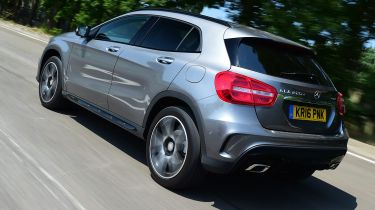Used Mercedes GLA (Mk1, 2013-2020) review - How much will it cost?
The entry-level GLA is cheap to run, although it's more expensive to buy than its rivals
The Mercedes GLA was an expensive car to buy new. In many respects you were paying for the badge, especially when you consider that the Mk1 GLA was little more than an ‘A-Class on stilts’. Depreciation is less of a problem on a small Mercedes than it is on the larger saloons and SUVs, but a GLA with a raft of options is likely to lose more money in the first few years. Good news if you’re buying used.
Prices
You could spend as little as £14,000 on an early GLA, but this is likely to be an SE with the entry-level 200 d engine. Add another £5,000 for a facelifted version or £7,000 for a GLA45 AMG. Bank on spending at least £22,000 on a GLA still covered by its original manufacturer’s warranty. That said, with the new and improved GLA available for around £27,000, you might want to increase the budget, especially when the difference in the monthly repayments should be minimal.
You can check out the latest used prices for the Mercedes GLA on our Find a Car service or check the value of a specific model with our free car valuation tool.
Fuel economy and CO2 emissions
With a range of petrol engines being the only ones on offer after spring 2019, the Mercedes GLA has to give second best to its rivals for fuel efficiency. Under the latest WLTP test procedure, the GLA 180 manages up to 40.4mpg with the manual gearbox, while the auto-equipped version manages up to 39.2mpg. Go for the GLA 200, and these figures are 39.8mpg and 38.2mpg respectively. Move up to the 2.0-litre turbo petrol GLA 250, and it manages up to 35.8mpg, because it's pegged back by its standard-fit 4MATIC four-wheel drive and auto gearbox.
The best-performing GLA models for fuel economy are the diesels. Whether you go for a manual or automatic gearbox, the front-wheel-drive Mercedes GLA 200 d is a cheap car to run, with a claimed 46.3mpg under the WLTP tests, while CO2 emissions stand at around 150g/km irrespective of whether you go for an automatic or manual.
The GLA 220 d features a more powerful version of the same engine, with 175bhp, but still shouldn’t break the bank when it comes to running costs. The official economy figure is quoted at 47.9mpg for the standard car and 47.1mpg for the AMG Line, although these figures are the older NEDC rates, and you're more likely to achieve the claimed WLTP figures in the GLA 200 d in the real world.
Running costs
All GLAs need to be serviced every 12 months or 15,500 miles. Rates vary, so it’s worth shopping around to save money; you can get quotes from any official dealer at www.mymercedesservice.co.uk. Services alternate between minor and major, priced at around £250 and £425 respectively for diesels, while petrol-engined cars are about £240 and £340.
The big service is the fourth one, priced at £700-£750. The brake fluid needs to be replaced every two years (at £80), while the coolant needs to be renewed once every 15 years. All GLA engines are chain-driven so there’s no need for any replacement cam belts.
Insurance is another area in which the Mercedes is potentially going to be more expensive than its key competitors.
You’re looking at groups 22 and 23 for the GLA 180 and 200 models, while the GLA 250 sits in groups 28-30, depending on specification. However, entry-level versions of the Audi Q3 and BMW X1 start lower in the 20s and, with the exception of the flagship Audi RS Q3, neither rival exceeds insurance group 30, regardless of the model.
Mercedes has put a lot of work into improving its residual values, and small SUVs with premium badges are known for holding their money well, so the GLA will be less prone to depreciation than rivals.







